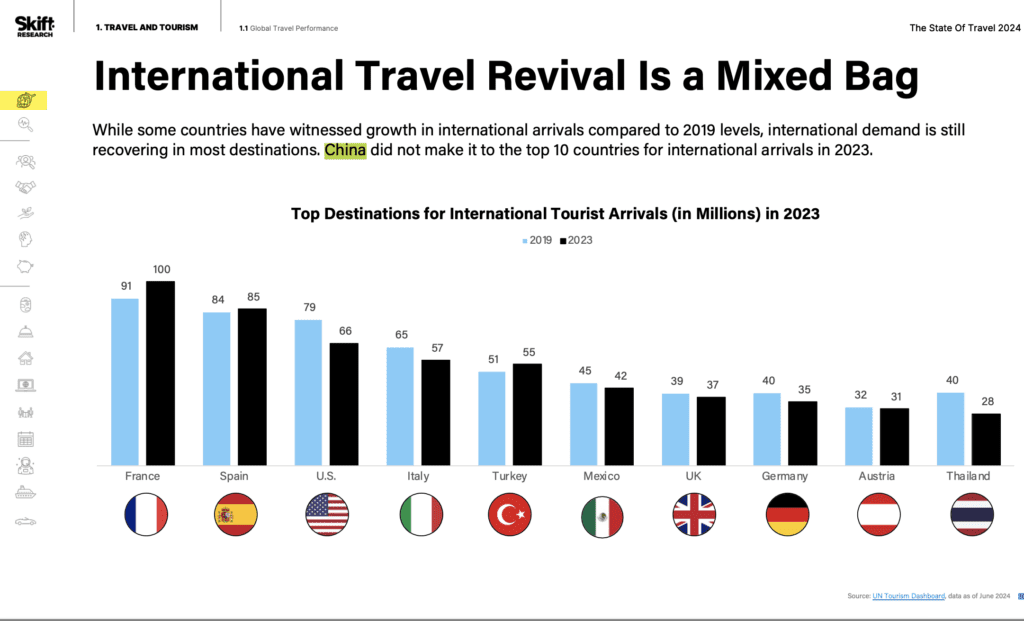Skift Take
Chinese tourism, both inbound and outbound, remains far below pre-Covid levels. Despite recent gains, China has significant ground to recover in its travel sector.
China brought in over 17.25 million foreign tourists from January to July this year, a 130% increase compared to 2023, according to latest data from the National Immigration Administration (NIA). The influx is set to generate over CNY 100 billion ($14 billion) in consumer spending, with per capita daily spending nearing CNY 3,459 ($485).
Despite the jump, China’s inbound arrivals are still far away from its 2019 numbers, when it had over 49 million overseas visitors. International tourism revenue reached $131.3 billion that year.
Visa-Exemption Policies
The surge in inbound tourism this year has been largely driven by the rollout and expansion of visa-exemption policies. The 144-hour visa-free transit policy now covers 37 ports and applies to citizens from 54 countries, including the U.S., Canada, and the UK. This policy lets travelers with valid international travel documents and onward tickets stay in designated areas of China for up to six days without a visa.
The NIA has also rolled out several region-specific visa-free entry policies. These include a 144-hour visa-free entry for foreign tour groups from Hong Kong and Macao into South China’s Guangdong Province, and for Southeast Asian country tour groups into Guilin, South China’s Guangxi Zhuang Autonomous Region. There’s also a 30-day visa-free entry for nationals from 59 countries into Hainan Province, and a 15-day visa-free entry for cruise ship tourists in coastal provinces.
China has also implemented a new 144-hour visa-free entry policy into Hainan for foreign tourist groups registered in Hong Kong and Macao. Over 5.9 million foreign tourists have traveled on this, according to NIA. In July, China extended the 144-hour visa-free transit to nine additional cities in Yunnan Province, including popular destinations like Lijiang and Dali.
Surge in Searches
In addition to visa exemptions, the NIA has made it easier for foreigners to apply for port visas at 100 visa offices across 73 cities in China. This change is particularly beneficial for those needing to enter the country on short notice for business or other urgent matters. Between January and July, China issued around 846,000 port visas to foreign nationals, marking a 183% increase from the previous year.
Trip.com has noted that in the first quarter of 2024, there was a 400% growth in inbound travel to China, driven by the benefits of such visa-free policies. After China announced visa-free travel for Australian tourists in June, Trip.com saw an 80% spike in China-related searches from Australian users within 30 minutes.
However, the rapid growth in inbound tourism has highlighted challenges in the sector, particularly regarding hotel services. Many foreign visitors have expressed concerns about the quality of lodging, prompting the ministry of commerce and six other departments to issue guidelines in July aimed at improving accommodation services for international guests.
As Skift Research noted in the latest State of Travel report, China did not make the list of top 10 countries for international arrivals in 2023.

The Digital Payment Switch
As China rapidly embraces a cashless economy, foreign travelers face a new challenge: adapting to a society where digital payments dominate. Traditional cash transactions are increasingly rare, with platforms like Alipay and WeChat Pay becoming the standard for everything from dining to transportation.
Alipay, the digital payment and lifestyle platform in China, announced on Wednesday that it now supports 16 languages on its app — English, Chinese, French, German, Italian, Spanish, Portuguese, Arabic, Russian, Turkish, Malay, Indonesian, Thai, Korean, Japanese, and Vietnamese.
According to Alipay, this service upgrade would enable international tourists, “to explore China like a local with Alipay,” using the language that they are familiar with.

